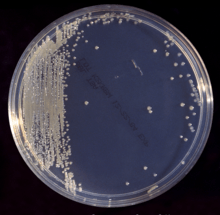Cronobacter sakazakii
| Cronobacter | |
|---|---|
 | |
| Scientific classification | |
| Kingdom: | Bacteria |
| Phylum: | Proteobacteria |
| Class: | Gamma Proteobacteria |
| Order: | Enterobacteriales |
| Family: | Enterobacteriaceae |
| Genus: | Cronobacter |
| Binomial name | |
| Cronobacter sakazakii (Farmer et al. 1980)[1] | |
Cronobacter is the officially recognised bacterial genus name for the organism which before 2007 was named Enterobacter sakazakii. The name Enterobacter should no longer be used as the genus name as Cronobacter has been accepted in the International Journal of Systematic and Evolutionary Microbiology, along with the description of the new species.[2][3] . It is a Gram-negative, rod-shaped, pathogenic bacterium. The majority of Cronobacter cases are in adults, and additionally it is associated with a rare cause of invasive infection of infants with historically high case fatality rates (40–80%).[4][5][6]
In infants it can cause bacteraemia, meningitis and necrotising enterocolitis. Some neonatal C. sakazakii infections have been associated with the use of powdered infant formula[4][6] with some strains able to survive in a desiccated state for more than two years.[7] However not all cases have been linked to contaminated infant formula. In November 2011, several shipments of Kotex tampons were recalled due to a Cronobacter (E. sakazakii) contamination.[8]
All Cronobacter species, except C. condimenti, have been linked retrospectively to clinical cases of infection in either adults or infants.. However multilocus sequence typing [9] has shown that the majority of neonatal meningitis cases in the past 30 years, across 6 countries have been associated with only one genetic lineage of the species Cronobacter sakazakii called 'Sequence Type 4' or 'ST4',[10] and therefore this clone appears to be of greatest concern with infant infections.
The bacterium is ubiquitous being isolated from a range of environments and foods, and the majority of Cronobacter cases are in the adult population. However it is the association with intrinsically or extrinsically contaminated powdered formula which has attracted the main attention.According to multilocus sequence analysis (MLSA) the genus originated ~40 MYA, and the most clinically significant species, C. sakazakii, was distinguishable ~15-23 MYA. .[11]
Taxonomy
E. sakazakii was defined as a species in 1980 by Farmer et al.. DNA-DNA hybridization showed that E. sakazakii was 53–54% related to species in two different genera, Enterobacter and Citrobacter. However, diverse biogroups within E. sakazakii were described and Farmer et al. suggested these may represent different species and required further research for clarification.[1]
The taxonomic relationship between E. sakazakii strains has been studied using full-length 16S rRNA gene sequencing, DNA-DNA hybridization, multilocus sequence typing (MLST), f-AFLP, automated ribotyping. This resulted in the classification of E. sakazakii as a new genus, Cronobacter within the Enterobacteriaceae, initially comprising four named species in 2007. The taxonomy was expanded to five named species in 2008, and more recently (2011) to seven named species.[2][3][12]
The initial four named species in 2007 were Cronobacter sakazakii (comprising two subspecies), C. turicensis, C. muytjensii and C. dublinensis (comprising three subspecies) plus an unnamed species referred to as Cronobacter genomospecies I. The taxonomy was revised in 2008 to include a fifth named species C. malonaticus, which in 2007 had been regarded as a subspecies of C. sakazakii. In 2012, Cronobacter genomospecies I was formally renamed Cronobacter universalis, and a seventh species was described called Cronobacter condimenti.
References
- ↑ 1.0 1.1 Farmer JJ III, Asbury MA, Hickman FW, Brenner DJ, the Enterobacteriaceae Study Group (USA) (1980). "Enterobacter sakazakii: a new species of "Enterobacteriaceae" isolated from clinical specimens". Int J Syst Bacteriol 30 (3): 569–84. doi:10.1099/00207713-30-3-569.
- ↑ 2.0 2.1 Iversen C, Mullane N, Barbara McCardell et al. (2008). "Cronobacter gen. nov., a new genus to accommodate the biogroups of Enterobacter sakazakii, and proposal of Cronobacter sakazakii gen. nov. comb. nov., C. malonaticus sp. nov., C. turicensis sp. nov., C. muytjensii sp. nov., C. dublinensis sp. nov., Cronobacter genomospecies 1, and of three subspecies, C. dublinensis sp. nov. subsp. dublinensis subsp. nov., C. dublinensis sp. nov. subsp. lausannensis subsp. nov., and C. dublinensis sp. nov. subsp. lactaridi subsp. nov". IJSEM.
- ↑ 3.0 3.1 Joseph et al. "Cronobacter condimenti sp. nov., isolated from spiced meat and Cronobacter universalis sp. nov., a novel species designation for Cronobacter sp. genomospecies 1, recovered from a leg infection, water, and food ingredients". Intl J Syst Evol Microbiol .
- ↑ 4.0 4.1 Centers for Disease Control and Prevention (CDC) (2002). "Enterobacter sakazakii infections associated with the use of powdered infant formula--Tennessee, 2001". MMWR Morb Mortal Wkly Rep 51 (14): 297–300. PMID 12002167. Free full text
- ↑ Lai KK (2001). "Enterobacter sakazakii infections among neonates, infants, children, and adults. Case reports and a review of the literature". Medicine (Baltimore) 80 (2): 113–22. doi:10.1097/00005792-200103000-00004. PMID 11307587.
- ↑ 6.0 6.1 Bowen AB, Braden CR (2006). "Invasive Enterobacter sakazakii disease in infants". Emerging Infect Dis 12 (8): 1185–9. doi:10.3201/eid1208.051509. PMC 3291213. PMID 16965695.
- ↑ Caubilla-Barron J & Forsythe S (2007). "Dry stress and survival time of Enterobacter sakazakii and other Enterobacteriaceae in dehydrated infant formula". Journal Food Protection 13: 467–472.
- ↑ "FDA Recall of Kotex Tampons". Seeger Weiss LLP. Retrieved 2012-02-29.
- ↑ Baldwin et al. "Multilocus sequence typing of Cronobacter sakazakii and Cronobacter malonaticus reveals stable clonal structures with clinical significance which do not correlate with biotypes". BMC Microbiology .
- ↑ Joseph and Forsythe (2011). "Association of Cronobacter sakazakii ST4 with neonatal infections". Emerging Infectious Disease.
- ↑ Joseph, E et al. (2012). "Diversity of the Cronobacter genus as revealed by multi locus sequence typing". J Clin Microbiol 50 (9): 3031–3039. doi:10.1128/JCM.00905-12.
- ↑ Iversen C, Lehner A, Mullane N et al. (2007). "The taxonomy of Enterobacter sakazakii: proposal of a new genus Cronobacter gen. nov. and descriptions of Cronobacter sakazakii comb. nov. Cronobacter sakazakii subsp. sakazakii, comb. nov., Cronobacter sakazakii subsp. malonaticus subsp. nov., Cronobacter turicensis sp. nov., Cronobacter muytjensii sp. nov., Cronobacter dublinensis sp. nov. and Cronobacter genomospecies 1". BMC Evol Biol 7: 64. doi:10.1186/1471-2148-7-64. PMC 1868726. PMID 17439656. Free full text